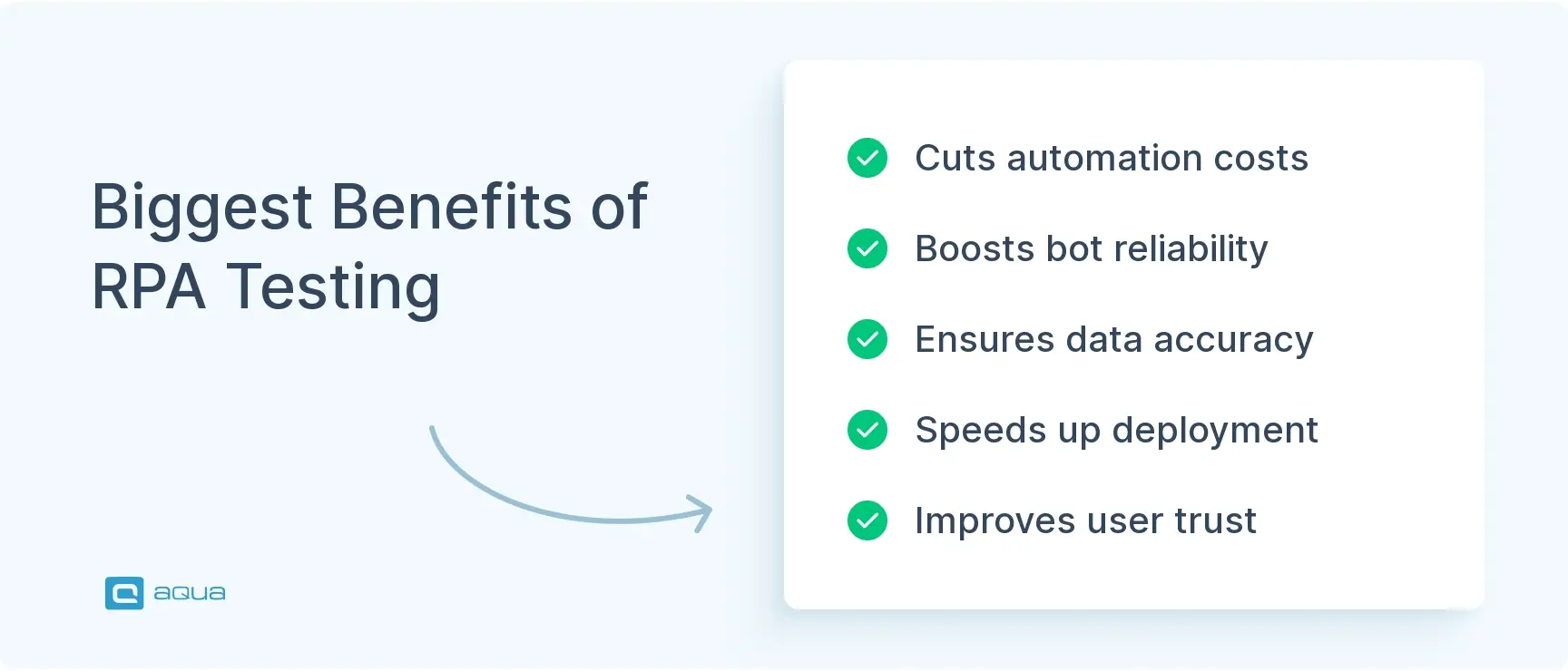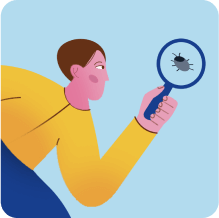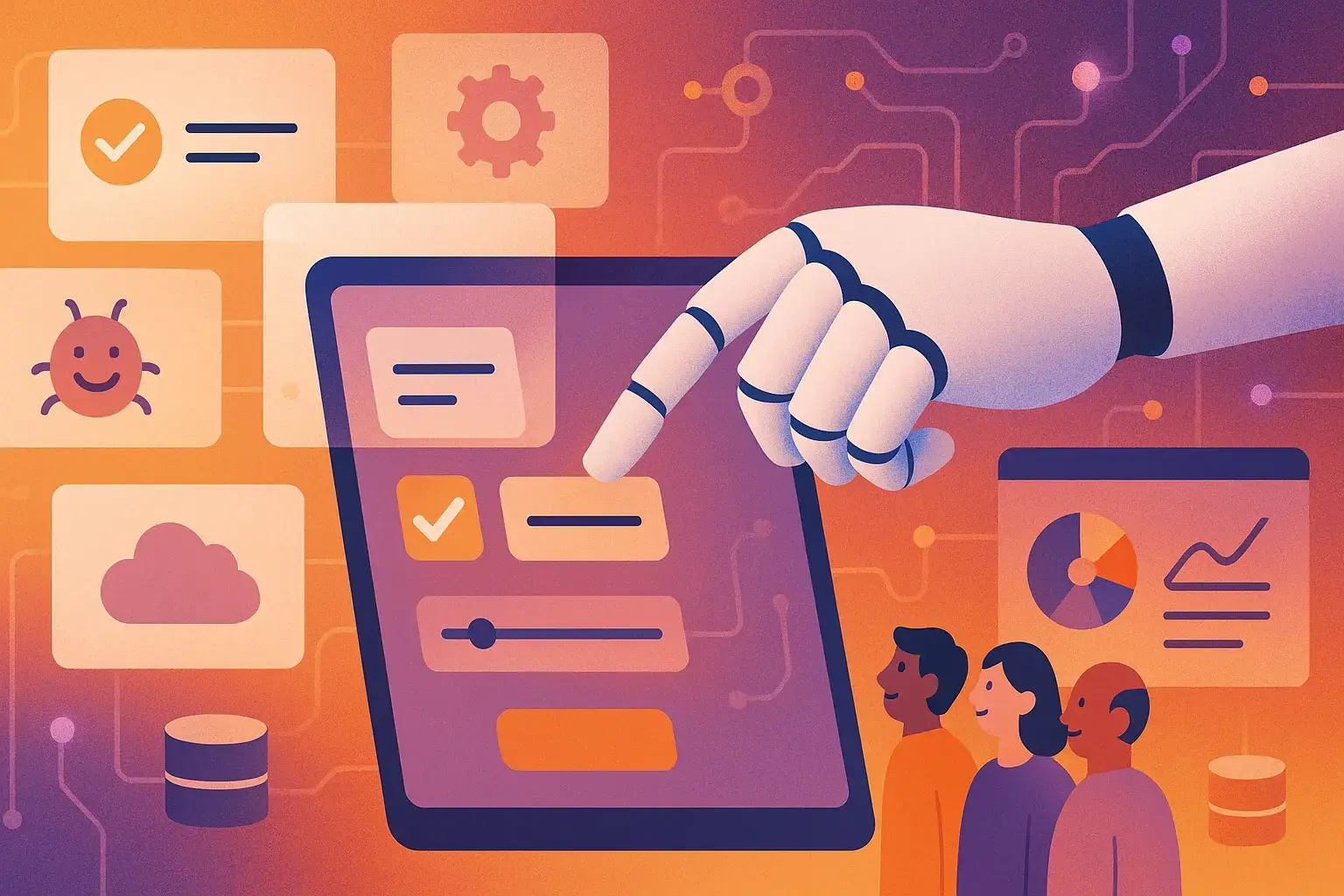What is RPA Testing?
So, what exactly is RPA testing? RPA is software that mimics human interaction with a computer. clicking, typing, or moving data around. It follows rules to handle repetitive tasks automatically. RPA testing isn’t about building bots; it’s about making sure they actually do what they’re supposed to. While regular software testing checks if code works as intended, RPA testing has a more layered job. You’re validating automation that was built to mimic real user actions across multiple systems, not just one app.
These bots might’ve been created by operations teams, business analysts, or IT, and your role as a tester is to make sure they hold up under pressure. Can they recover when things go wrong? Do they behave consistently across changing environments? That’s your job to find out. RPA testing handles the repetitive checks, so you can focus on the edge cases and failures that matter.The stakes couldn’t be higher. The global RPA market is expected to grow from $7.94 billion in 2024 to $9.91 billion in 2025, an annual increase of roughly 24.8%, showing how rapidly businesses are automating routine work, including testing across industries. Yet here’s the sobering reality: nearly 40% of RPA implementations crash and burn, often because teams skipped the testing phase or treated it like an afterthought.
Here’s what makes RPA testing uniquely challenging: your bots aren’t just running in one clean environment. They’re moving between that ancient CRM system from 2003, your shiny new cloud dashboard, and everything in between, all while trying to mimic human behaviour that’s inherently unpredictable. When you’re testing RPA bots, you’re essentially running them through boot camp. Here’s what that looks like:
- Process validation: Does your bot actually follow the workflow you designed, or does it wander off like a confused intern on their first day?
- Exception handling: What happens when your bot hits a roadblock? Will it freeze up completely, or can it figure out a workaround without calling for help?
- Integration testing: Can your bot actually talk to all the systems it needs to, or will it crash the moment it tries to connect to that ancient database everyone’s afraid to touch?
- Performance testing: Is your “super-fast” automation actually faster than doing it manually, or are you just automating inefficiency?
- Maintenance testing: When IT inevitably breaks something with their next update, will your bot adapt, or will you be rebuilding everything from scratch?
When RPA Testing is Crucial:
Timing your RPA testing right is the difference between effective automation and expensive disasters. Here are the critical moments when testing becomes non-negotiable:
- During initial development: Before your bot touches any live data or real processes
- After system changes: When IT updates any application your bot depends on (spoiler: this happens more than you think)
- For compliance purposes: When auditors need proof your automation follows regulations and doesn’t cut corners
- When scaling: Before unleashing your bot army across multiple departments where failure gets expensive fast
- After bot modifications: Every time you tweak your bot’s logic or add new functionality
RPA testing catches the failures that could tank your entire automation project. A minor interface change in one system can break your bot’s workflow, leaving you with corrupted data, missed deadlines, and a manual cleanup job that’s worse than never automating in the first place.
Benefits of RPA Testing
RPA testing pays off in ways that go far beyond catching bugs. When your testing strategy actually works, the benefits show up across your entire operation.
Cost Reduction
Proper testing catches expensive mistakes before they happen. Your bots won’t corrupt production data, crash critical systems, or require emergency weekend fixes that cost triple overtime rates. Organisations with solid testing frameworks report 25-50% cost savings because their bots actually work as intended from day one. Less debugging means less money spent on consultant hours and fewer frustrated employees cleaning up automated messes.
Quality Assurance
Testing ensures your bots deliver the same reliable output every single time. Business rules get implemented correctly, data stays clean, and transactions are processed without errors. You’ll have clear audit trails that compliance teams actually trust. No more wondering if your automation is secretly making mistakes that’ll surface during the next audit.
Enhanced Bot Reliability
Well-tested bots don’t break every time IT pushes an update. They handle unexpected scenarios gracefully and keep running when applications hiccup. Your team stops playing “bot babysitter” because the automation actually works independently. Stakeholders start trusting your RPA program instead of questioning every automated decision.
Faster Time to Value
Solid testing accelerates everything else. You deploy faster because you’re confident the bots work. Scaling happens quicker because you’re not constantly fixing basic issues. Clear performance metrics show exactly where automation adds value, making it easier to justify expanding the program. Each new bot builds on proven testing frameworks instead of starting from scratch.
User Satisfaction
Nobody likes broken automation that creates more work than it saves. Proper testing ensures smooth handoffs between humans and bots. Employees trust the system because it consistently works as promised. People focus on meaningful work instead of babysitting temperamental automation.

So, a smart RPA testing transforms automation from a risky experiment into a reliable business advantage. Got the benefits, now let’s move on to the methods of doing it.
As you explore the world of RPA testing, it’s clear that the right toolset can make all the difference between automation that occasionally works and automation you can truly rely on. This is where aqua cloud comes in as your strategic advantage. With its AI-powered capabilities, aqua seamlessly centralizes both manual and automated tests in one platform, allowing you to manage your RPA testing lifecycle with unprecedented efficiency. Unlike conventional tools, aqua’s AI Copilot can generate comprehensive test cases in seconds using techniques like Boundary Value Analysis and Equivalence Partitioning, cutting test case creation time by up to 98%. What’s particularly valuable for RPA testing is aqua’s ability to integrate with any automation framework through its robust REST API, ensuring you maintain complete visibility across all your testing activities. With aqua, you’re not just testing RPA bots, you’re transforming your entire approach to quality assurance.
Save up to 10.5 hours per week per QA specialist with aqua's AI-powered test management
RPA Testing Methods
Your RPA testing strategy needs different approaches to catch different types of problems. Each method has a specific purpose in making sure your bots actually work when it matters.
Unit Testing
Unit testing checks individual pieces of your bot before you put them together. You’re testing each puzzle piece to make sure it’s not broken before trying to build the whole picture.
What to test:
- Individual activities or commands within the RPA workflow
- Input validation rules
- Specific bot functions (like data extraction or transformation logic)
- Error handling for specific components
How it works: Developers create these small, focused tests during bot development. Each test verifies that one building block works correctly before combining it with others. Think of it as quality control for your bot’s individual functions.
Real-world application: Your invoice processing bot needs to extract invoice numbers, validate dates, and calculate totals. Unit testing checks each of these functions separately before testing the complete workflow.
Integration Testing
Integration testing makes sure your bot can actually talk to all the systems it needs to work with. This is where you find out if your bot plays well with others.
What to test:
- Connections between the bot and target applications
- Data transfer between systems
- Authentication mechanisms
- API interactions
How it works: These tests simulate your bot working across multiple applications, focusing on how systems hand off data to each other rather than testing complete business processes.
Real-world application: Your HR onboarding bot needs to access the applicant tracking system, HR database, email server, and document management system. Integration testing verifies that all these connections work properly.
Regression Testing
Regression testing catches problems that pop up when something changes in your environment. Systems get updated constantly, and you need to know if those changes broke your automation.
What to test:
- Bot behaviour after updates to the RPA platform
- Functionality following changes to target applications
- Performance after OS updates or patches
- Compatibility with new browser versions
How it works: You run these tests whenever something changes in your environment. They typically reuse test cases from functional testing to verify that existing functionality still works.
Real-world application: Your CRM system pushes its quarterly update. Regression testing verifies your customer data extraction bot still works correctly with the new interface.
Security Testing
Security testing ensures your bots don’t accidentally create security holes that hackers can exploit. This becomes critical when bots handle sensitive data or have system access.
What to test:
- Credential management
- Access control mechanisms
- Data privacy compliance
- Bot privilege levels
- Secure handling of sensitive information
How it works: Security testing combines automated scanning with manual reviews of bot configurations, credential storage, and access permissions. You’re looking for vulnerabilities before attackers do.
Real-world application: Your healthcare claims processing bot handles patient data. AI security testing verifies that patient information stays encrypted, access gets properly logged, and the bot only touches authorised systems.
User Acceptance Testing (UAT)
UAT is the final check where actual business users test the bot with real-world scenarios. This is where you discover if your automation actually solves the problems it was designed to fix.
What to test:
- End-to-end business processes
- Business rule implementation
- Exception handling in real-world conditions
- User handoffs and interventions
How it works: Business users and process owners test the RPA solution with actual data and realistic scenarios. They’re checking if the bot meets their needs and expectations, not just technical requirements.
Real-world application: Your accounts payable bot processes invoices from receipt to payment. Finance team members test the complete workflow, including common exceptions like missing vendor information or approval workflows.
RPA Testing Phases
RPA testing happens in stages, and each one builds on the previous step. Skipping phases usually means backtracking later with bigger problems to solve.
Planning and Requirements Analysis: You start by figuring out what actually needs testing. This means digging into business requirements, process documentation, and having honest conversations with the people who’ll use your bot. What are the critical functions? What could go wrong? What would “success” look like to the business users?
Test Design: Now you create test cases that cover everything your bot needs to do. Think beyond the happy path – what happens when data is missing, systems are slow, or users do unexpected things? Your test cases should reflect real-world chaos, not idealised workflows.
Test Environment Setup: You build isolated environments that mirror your production setup without the risk of breaking live systems. This includes setting up test data, configuring access permissions, and ensuring your test environment actually behaves like the real thing.
Test Execution: Time to run your tests and document what happens. This phase reveals the gap between how you think your bot works and how it actually performs. Keep detailed records – you’ll need them when explaining why certain fixes are necessary.
Defect Resolution: You fix the issues your testing uncovered. This is more than just about patching bugs – sometimes you discover fundamental design problems that require rethinking your approach. Document what you changed and why.
Regression Testing: After fixing issues, you re-test everything to make sure your fixes didn’t break something else. This phase catches the “fixed one thing, broke three others” scenarios that plague automation projects.
User Acceptance Testing: Business users take your bot for a test drive with real scenarios. They’ll find edge cases your technical testing missed and tell you if the automation actually solves their problems or just creates new ones.
Performance Monitoring: Testing doesn’t end at deployment. You monitor how your bot performs in the wild, tracking metrics like success rates, processing times, and exception frequencies. This ongoing feedback informs future improvements and catches issues before they impact business operations.
Each phase serves as a checkpoint that prevents small problems from becoming expensive disasters.
Challenges of RPA Testing and Solutions
RPA testing comes with its own set of headaches that can harm even well-planned automation projects. Here’s how to tackle the most common problems:
Challenge: Dynamic UI Elements
Modern applications love changing their interfaces, which breaks bots that depend on finding specific buttons or fields in exact locations.
Solution: Use AI-based object recognition instead of fixed coordinates. Build multiple ways to identify critical elements so your bot has backup options. Create self-healing scripts that adapt to minor UI changes automatically. Maintain a central library of UI element properties that gets updated in one place.
Pro tip: Run regular health checks where bots test key scenarios after any application updates.
Challenge: Test Data Management
You need realistic test data that looks like production data without exposing actual customer information or sensitive business details.
Solution: Create synthetic datasets that mirror real-world scenarios. Aqua cloud can help you generate this kind of dataset in seconds. Use data masking tools when working with production data copies. Build a test data repository covering common situations and edge cases. Generate volume test data when you need to simulate high-load conditions.
Challenge: Environment Availability
Your bots need access to multiple systems for testing, but legacy applications often don’t have dedicated test environments available.
Solution: Create virtualised versions of critical applications where possible. Schedule testing during off-peak hours for shared systems. Use service virtualisation tools to simulate system responses. Build mock interfaces for systems you can’t access directly during testing.
Challenge: Complex Business Rules
Real-world processes contain complicated decision logic and exception handling that’s nearly impossible to test completely.
Solution: Develop decision tables mapping all possible inputs to expected outcomes. Prioritise test cases based on business impact rather than trying to test everything. Use pairwise testing to reduce test combinations while maintaining coverage. Create visual process maps highlighting decision points for targeted testing.
Challenge: Lack of Specialised Skills
Most teams don’t have people who understand both RPA development and comprehensive testing strategies.
Solution: Cross-train existing QA staff on RPA concepts and tools. Pair RPA developers with experienced testers during test design. Invest in RPA-specific testing certifications for key team members. Bring in specialised consultants for initial test strategy development.
Challenge: Performance and Scalability
Bots that handle small data volumes perfectly often crash when faced with production-level workloads.
Solution: Implement performance testing with gradually increasing data volumes. Test multiple bot instances running simultaneously. Monitor resource usage during extended test runs. Simulate network delays and system slowdowns to test resilience.
Knowing how to solve these challenges is half the battle. The other half is implementing proven practices that prevent most problems from happening in the first place.
Best Practices for Effective RPA Testing
These proven practices help you avoid the most common RPA testing pitfalls and build automation that actually works reliably.
-
Start with Process Mining
Understanding how processes actually work (versus how they’re supposed to work) prevents you from testing the wrong thing entirely.
Analyse process logs to identify variations and exceptions that the documentation missed. Map the real process flow, including all those unofficial workarounds people use daily. Document business rules you discover during mining – these often become your most important test cases.
-
Create a Dedicated Testing Environment
Testing RPA bots in production is asking for expensive disasters. Your test environment needs to mirror production without the risk of breaking live systems.
Include all applications your bot will touch. Configure similar performance characteristics so testing reflects real conditions. Populate with representative test data that covers normal and edge cases. Keep it updated when production systems change.
-
Develop a Comprehensive Test Plan
Planning your testing approach upfront prevents scope creep and missed requirements later.
Define what you’re testing and why. Establish clear criteria for when testing starts and when it’s complete. Identify required resources, tools, and realistic timelines. Assign specific roles and responsibilities so everyone knows their part.
-
Prioritise Test Cases by Business Impact
Focus your testing energy where failures would cause the most damage.
Start with high-risk processes that affect finances, customers, or compliance. Consider how often the process runs and how visible failures would be. Factor in technical complexity – simple processes might still be high-risk if they handle critical data. Allocate your most thorough testing to these high-impact areas.
-
Incorporate Exception Testing
Your bot’s real test comes when things go wrong, not when everything works perfectly.
Test with invalid inputs, corrupted files, and missing data. Simulate system outages and network slowdowns. Verify timeout scenarios and error handling. Confirm your bot logs problems properly and notifies the right people. Make sure recovery processes actually work when systems come back online.
-
Automate Your RPA Testing
Testing automation with more automation might sound recursive, but it’s essential for maintaining quality as your program scales.
Create reusable test components that work across multiple bots. Implement continuous testing that runs automatically when code changes. Build automated regression test suites for frequent validation. Consider test-driven development, where you write tests before building bot functionality.
-
Monitor Bot Performance
Deployment marks the beginning of ongoing performance management, not the end of testing.
Track execution times, success rates, and exception frequencies. Look for trends that indicate degrading performance or emerging issues. Compare current metrics to baseline performance. Schedule regular audit runs in test environments. Set up proactive alerts before problems impact business operations.
-
Document Everything
Detailed documentation prevents knowledge loss and speeds up troubleshooting when issues arise.
Maintain comprehensive test cases with expected results and actual outcomes. Document known limitations and workarounds. Create troubleshooting guides for common problems. Build a knowledge base of past issues and solutions. Record test results with screenshots and logs for future reference.
Now let’s move on to the dedicated solutions that will help you implement these practices.
Popular Tools for RPA Testing
Choosing the right tools will dramatically improve your RPA testing efficiency. But based on what? Here’s a comparison of leading solutions:
| Tool | Best For | Key Features | Limitations | Pricing Model |
|---|---|---|---|---|
| UiPath Test Suite | End-to-end RPA testing in UiPath ecosystem | • Native integration with UiPath • Test case recorder • Visual test builder • Reusable test components |
• Limited functionality with non-UiPath RPA • Steeper learning curve |
Subscription, part of UiPath platform |
| Automation Anywhere Testing | Testing AA bots | • Deep integration with AA platform • Performance analytics • Bot insight dashboards • Exception prediction |
• Primarily for AA bots • Less suitable for cross-platform testing |
Included with enterprise licenses |
| Blue Prism Assurance | Blue Prism bot testing | • Process validation • Visual business object testing • Exception monitoring • Compliance reporting |
• Blue Prism ecosystem only • Limited API testing capabilities |
Part of enterprise package |
| Workfusion Test Factory | Testing AI-enhanced RPA | • ML-based testing • Anomaly detection • Predictive test case generation • Self-improving tests |
• Complex setup • Requires data science expertise |
Enterprise licensing |
| Selenium | Web-based RPA testing | • Open source • Extensive community • Flexible scripting • Browser automation |
• Limited desktop application support • Requires coding skills |
Free (open source) |
| Leapwork | No-code RPA testing | • Visual test builder • Business-friendly interface • Cross-platform testing • AI-assisted testing |
• Less integration with RPA platforms • Higher cost |
User-based subscription |
Choosing the Right RPA Testing Tool
Your tool selection can make or break your testing strategy. Here’s what matters most when evaluating options:
RPA Platform Compatibility: Pick tools that work seamlessly with your existing RPA platform. Native integration means fewer compatibility headaches and better access to bot internals for debugging.
Technical Skill Requirements: Match tool complexity to your team’s current abilities. A powerful tool that nobody can use effectively is worse than a simpler one that gets implemented properly.
Application Coverage: Verify the tool supports all technologies your bots interact with – legacy systems, web applications, APIs, and desktop software. Gaps in coverage create blind spots in your testing.
Scalability: Consider how the tool performs with large test suites and multiple concurrent users. What works for a pilot project might crash under enterprise-scale testing loads.
Reporting Capabilities: Look for tools that provide actionable insights beyond simple pass/fail results. You need detailed error information, performance metrics, and trend analysis to improve your bots.
Integration Options: Check how well the tool fits into your existing testing framework, CI/CD pipelines, and reporting infrastructure. Isolated tools create information silos.
Cost Structure: Calculate total ownership costs, including licenses, training, ongoing maintenance, and potential scaling expenses. The cheapest upfront option often becomes expensive over time.
You need a combination approach – platform-specific tools for deep integration and third-party tools for broader coverage or specialised testing requirements.
Building an RPA Testing Framework
A solid testing framework keeps your RPA testing consistent and efficient across multiple projects. Your framework needs these core components:
Standardised Templates and Components: Create reusable test case templates and common test components that work across different bots. Build centralised object repositories so teams aren’t recreating the same elements repeatedly.
Automation and Integration: Include automated reporting that shows meaningful results, not just data dumps. Integrate with version control systems and CI/CD pipelines so testing happens automatically when code changes.
Error Management: Build exception handling libraries that capture detailed error information and provide consistent recovery mechanisms across all your bots.
Your framework should standardise common tasks while staying flexible enough to handle different business processes and RPA platforms. The best frameworks evolve based on real implementation experience rather than trying to anticipate every possible scenario upfront.
RPA vs Automation Testing
Should you treat RPA testing the same as regular software testing? The short answer is no – they solve different problems and require different approaches.
| Aspect | RPA Testing | Traditional Automation Testing |
|---|---|---|
| Primary Focus | Testing bots that automate business processes | Testing software functionality |
| Interaction Level | Works at the UI layer, mimicking human actions | Often works at API or code level |
| Technical Requirements | Often low-code/no-code | Typically requires programming skills |
| Business Knowledge | Heavily dependent on business process expertise | More focused on technical requirements |
| Target Users | Business analysts and RPA developers | QA engineers and developers |
| Cross-Application Support | Native cross-application capability | Usually focused on a single application |
| Data Handling | Process-oriented data validation | Function-oriented data validation |
| Exception Handling | Emphasis on business exceptions | Emphasis on technical failures |
Understanding these differences helps you choose the right testing approach for your specific situation. If you’re working with business processes that span multiple applications, especially legacy systems without modern APIs, RPA testing tools often provide better coverage than traditional automation testing methods.
Conclusion
Your RPA bots handle critical business functions, so they need the same high testing standards as any mission-critical software. Do a comprehensive testing across your entire RPA lifecycle, and you’ll reduce operational risks, improve bot reliability, and get real value from your automation investments. Start by assessing your current approach against the methods covered in this guide – identify gaps, prioritise improvements, and build a testing framework that actually supports your automation goals rather than just checking compliance boxes.
As we’ve seen, effective RPA testing requires a comprehensive approach spanning multiple methods and tools. But managing this complexity doesn’t have to be overwhelming. aqua cloud stands out as the ideal companion for your RPA testing journey by providing a unified platform where both manual and automated tests coexist seamlessly. With aqua’s AI Copilot, you can automatically generate test cases and test data in seconds, addressing one of the biggest challenges in RPA testing—comprehensive test coverage. The platform’s integration capabilities allow you to connect with any CI/CD tool, project management system like Jira, or documentation hub like Confluence, creating a cohesive ecosystem for your entire testing workflow. Unlike standalone testing tools, aqua delivers full traceability from requirements through test execution to defect management, ensuring your RPA implementations meet both technical and business requirements. By centralizing your RPA testing in aqua, you eliminate tool-switching, reduce documentation overhead, and gain powerful insights through customizable dashboards—ultimately making your automation truly reliable.
Achieve 97% time savings on test case creation and 100% test coverage for your RPA solutions


















